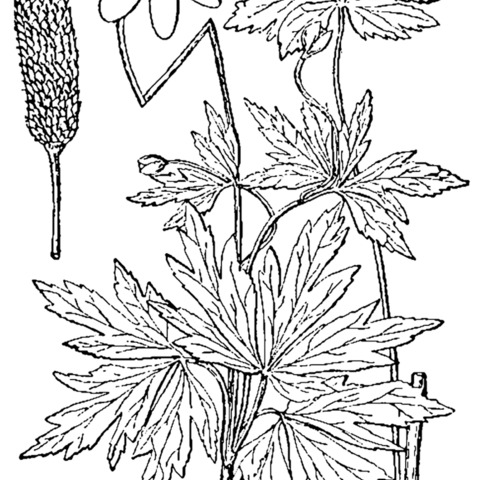Aerial shoots (20-)30-70(-80) cm, from caudices, rarely with very short ascending rhizomes, caudices ascending to vertical. Basal leaves (2-)5-10(-13), ternate; petiole 9-21 cm; terminal leaflet sessile, broadly rhombic to oblanceolate, (2.5-)3-5(-6) × (3-)4-10(-14) cm, base narrowly cuneate, margins crenate, or serrate and deeply incised on distal 1/2, apex narrowly acute, surfaces strigose, more so abaxially; lateral leaflets 1-2×-parted and-lobed; ultimate lobes 4-10(-13) mm wide. Inflorescences (1-)2-8-flowered cymes, sometimes appearing umbellike; peduncle villous to densely villous; involucral bracts 3-7(-9), 2(-3)-tiered (can appear 1-tiered), ternate, ±similar to basal leaves, bases distinct; terminal leaflet sessile, rhombic to oblanceolate, 2.5-6.5 × (1-)1.5-2(-2.5) cm, bases narrowly cuneate, margins serrate and incised on distal 1/3-1/2, apex narrowly acute, surfaces puberulous, more so abaxially; lateral leaflets 1(-2)×-parted or-lobed; ultimate lobes (4-)6-10(-15) mm wide. Flowers: pedicel usually appearing bractless; sepals 4-5(-6), green to whitish, oblong to elliptic or ovate, 5-12(-15) × 3-6 mm, abaxially silky, adaxially glabrous; stamens 50-75. Heads of achenes cylindric; pedicel 10-30 cm. Achenes: body ovoid, (1.8-)2-3 × 1.5-2 mm, not winged, woolly; beak usually recurved, (0.3-)0.5-1 mm, hidden by achene indument, glabrous. 2 n =16.
More
Plants 3–10 dm, from a short caudex; basal and involucral lvs similar, the former several, the latter 3–10 and commonly twice as many as the mostly naked peduncles, both types petiolate, broad, deeply 3–5-parted into basally narrow and cuneate segments that are again few-toothed or cleft above the middle; peduncles mostly 2–6, 1–3 dm; sep 5(6), greenish-white, 8–12 mm long; styles crimson in life; fruiting head dense, cylindric, 2–4.5 cm, scarcely 1 cm thick; achenes densely woolly, 2 mm, the style 0.5–1 mm, subglabrous, seldom strongly spreading; 2n=16. Dry, open woods and prairies; Me. to B.C., s. to N.J., O., Mo., and Ariz. June–Aug.
Prairies, dry, open woods, pastures and roadsides at elevations from 300-3,000 metres.

